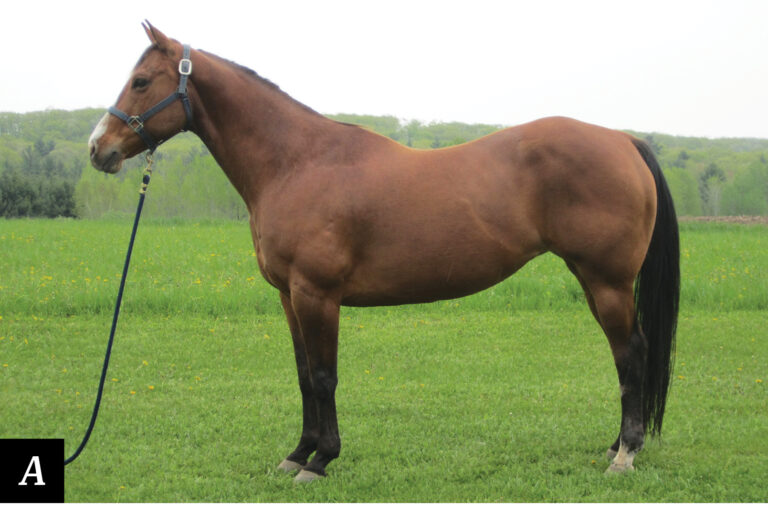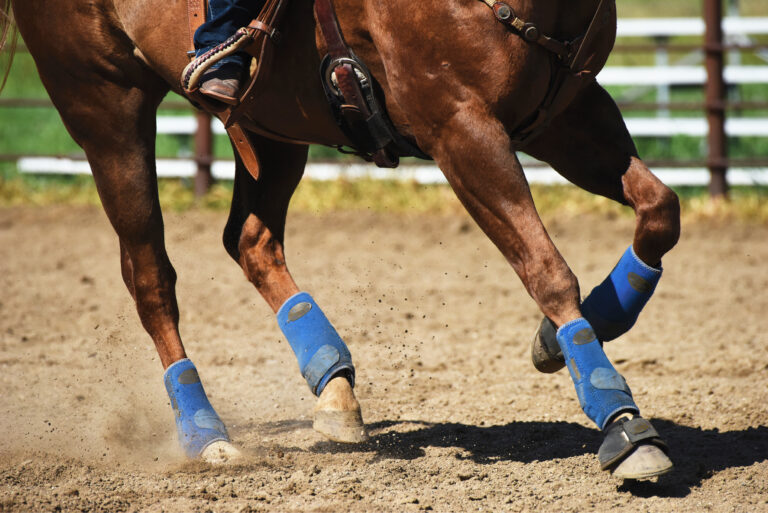It’s the night before a big show. You’ve worked at your “day job” all day, and now have a long night of prep ahead of you. Hours later, your horse is squeaky clean, outfitted in a sleazy, and covered with a sheet. You fall into bed, smelling like wet horse.

At the show the next morning, you notice that although your horse is clean and well-turned-out, he doesn’t shine like the others. Their secret: A commitment to a daily grooming regimen.
As an AQHA Professional Horseman, I frequently receive compliments from other trainers, exhibitors, and the judges on the quality of my horses’ coats, which I credit to my daily grooming routine.
Here I’ll share the five techniques I use every day with my horses at Empire Performance Horses, to achieve the eye-catching sheen my horses are known for. I’ll also include tips for two techniques I use a few days prior to a show.
Before getting started, it’s important to remember that no amount of grooming can substitute for proper nutrition and a regular deworming program. Work closely with your veterinarian to develop a ration to support your horse’s digestive health and to create a deworming schedule suitable for your horse.
Now it’s time to roll-up your sleeves and use some elbow grease.
YOUR ROUTINE
When time is tight, it’s tempting to shortcut on the grooming. But if you want your horse’s coat to gleam, you won’t skimp. Cutting a day here or there isn’t detrimental if you just don’t have time, but consistency and frequency results in the most noticeable changes. Here are daily tasks, as well as those best completed a few days leading up to a show and the night before.
Daily Habits
Task: Deep-down brushing.
Time: Three to five minutes per side, before and after every workout.
Get to work: Currying sounds like a no-brainer. It’s perhaps the first thing horse owners learn how to do. But don’t take for granted the benefits from a good currying.
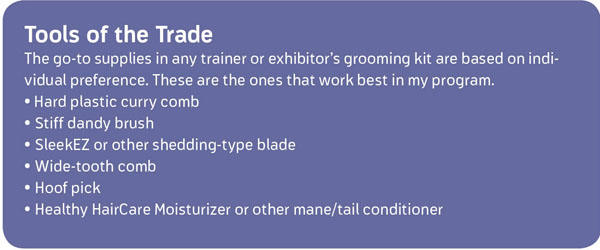
The sharp teeth on plastic currycombs are designed to get deep into the horse’s coat, pulling dander and shedding hair to the surface. Some include a hose attachment, allowing it to serve double duty on bath day. Not only does the currycomb remove dirt and shedding hair, it stimulates production of the natural oils in the horse’s skin, which provide a glossy shine.
Begin behind the horse’s ears. Work in a circular motion moving down your horse’s neck, toward his shoulder. Continue along the horse’s side, under his belly, and back to his rump. Either lighten your touch on his legs to avoid harming sensitive structures, or don’t use the brush below the knees or hocks. For best results, curry before and after every workout.
Use a stiff dandy brush after currying. Short, flicking strokes remove dirt and hair brought to the surface through currying.
Task: Post-workout coat conditioning.
Time: Less than one minute.
Get to work: Once post-workout currying is complete, spritz the entire coat with Healthy HairCare Moisturizer or a similar product. Let the conditioner soak into the horse’s coat before blanketing or turning out. A lanolin-based product replaces vital oils to the hair and skin, controls dandruff and dry skin, and reduces static electricity.
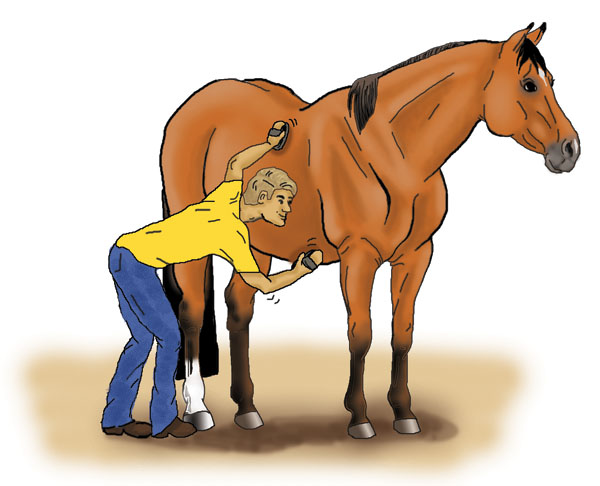
Task: Shedding with the SleekEZ or other shedding blade.
Time: Three to five minutes per side.
Get to work: This tool, essentially a block of wood with a grooming blade, quickly removes loose hair, dust, and dirt. It leaves the coat smooth and soft. I only use it during shedding season and to loosen mud and manure.
Hold the block by its smooth edge. Scrape the horse’s coat vigorously in the direction of growth in short, rapid strokes with the blade edge. Don’t use the blade on tender body parts, such as the face and legs. Be aware of your horse’s sensitivity to pressure; every horse tolerates different levels of contact with sharp grooming tools.
Task: Tail care.
Time: 10 minutes.
Get to work: Following a workout, but before currying, thoroughly spray your horse’s tail with Healthy HairCare Moisturizer or a similar product. Let the tail soak while you move onto currying.
After the tail has had time to soak (around 10 minutes, if you spend three to five minutes currying each side), grab your wide-tooth comb, and go back to the tail. Begin at the bottom of the tail to work out any snarls or knots, and carefully comb through smaller sections of hair until reaching the tail dock.
Burrs, twigs, and other debris caught in tail hairs can lead to breakage and must be carefully removed. Spray conditioner directly onto the burr or other offender. Gently massage the area until the debris easily falls out of the tail. Then gently comb the area. Keep an eye out for these types of snarls, and handle them promptly, especially if your horse has thin or weak tail hair.
Task: Hoof care.
Time: One minute per hoof.
Get to work: Clean each hoof before and after exercise sessions to remove compacted mud and manure. Check for cracks, and ensure that shoes are tightly secured to the hoof.
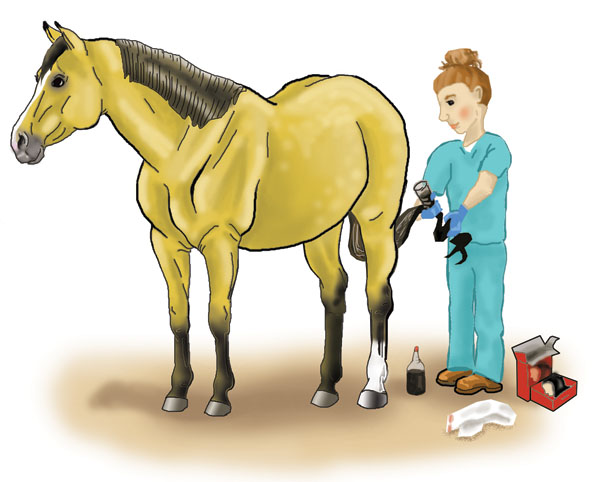
Depending on your horse’s needs, consider daily application of hoof oil or conditioner, especially if you frequently use hoof polish. Note: The high-gloss shine of hoof polish is eye-catching, but unhealthy and drying for the hoof itself, particularly at the coronet band. If possible, skip the hoof polish at weekend shows, and only use it when necessary. Be sure to check your association’s rulebook for details on which classes allow or prohibit hoof black.
Apply the hoof conditioner generously to all four hooves, beginning at the coronet band. Pick up each hoof and coat the soles and heels, too. If you’re unsure about your horse’s need for extra hoof conditioning, ask your farrier for advice.
Task: Remove stains.
Time: Five minutes or fewer, on an as-needed basis.
Get to work: Like the stain on your favorite piece of clothing, the longer a stain on your horse’s coat sits, the harder it is to remove. As soon as a stain appears, take care of it. Pre-workout, liberally spray the stain with Healthy HairCare Moisturizer or similar product. During exercise, the horse’s body will create enough oil to push the stain out. At the end of the ride, use a clean rag to wipe the remainder of the stain out.
Stubborn stains will need more work. Warm water and a stain remover work best to treat the area.
Three Days Out
Some show-prep grooming chores are best done a few days before a competition. These two in particular require additional time. Plan to spend an extra half hour or so at the barn to complete each task. Completing these tasks ahead of time allows the process to “set” so it looks more natural on show day and reduces stress the night before a show.
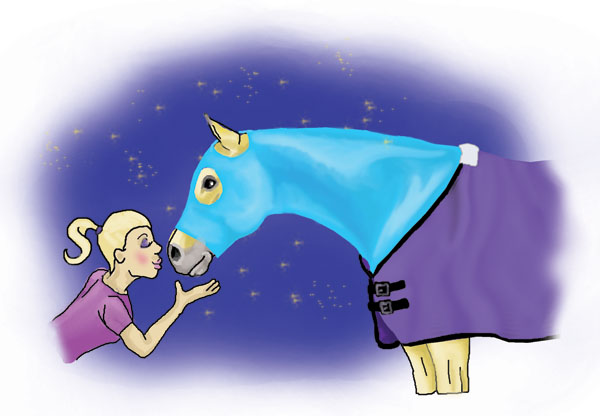
Task: Tail dyeing.
Time: One to two hours.
Get to work: First things first: Before using dyes or color enhancers of any kind on any part of your horse, review the rulebook for the association you are competing in. In most cases, you’re allowed to enhance, but not alter a horse’s markings. If you have any questions about enhancing your horse’s coat or markings, ask a trusted expert or judge. Also, consider if the “enhancement” is necessary and if you have the skills to complete the task.
That said, a coal-black tail accentuates an already gleaming coat, but exposure to the summer sun and urine can bleach or dull a dark tail. Human hair dye can restore your horse’s naturally dark-colored tail, in some cases.
First, wash and towel-dry the tail so that it’s damp, but not sopping wet. Apply the dye according to the directions on the box. It might take more than one box of dye to treat an entire tail, depending on your horse’s tail’s thickness and length.
Wrap the tail in a plastic garbage bag to keep the dye from transferring to other body parts—a simple swish of a tail can leave dark streaks on a light coat. At the end of the setting process, thoroughly rinse the dye from the tail, wash, and condition.
Repeat only as necessary throughout the show season to avoid damaging the hair.
Task: Clipping.
Time: Depends on your skills and your horse’s patience; usually about 30 minutes.
Get to work: A fresh, tight clip adds the finishing touches to a well-groomed horse. Plan to clip a few days prior to a show to give hair time to naturally fill in.
Use a #40 blade around the nostrils, muzzle, ears and bridle bath for a fine, tightly shaven cut.
I use a #10 blade for a close, clean shave on the legs, under the jaw, and on white facial markings. First, clip against the direction of hair growth. Then blend the edges of the clipped hair into the surrounding areas.
On show day, baby powder or Shapley’s Touch-Up White Enhancer makes white markings pop. Practice applying whitening products prior to the show to rule out any allergic reactions and to perfect application techniques.
Night Before
A daily grooming regimen doesn’t replace a thorough bath the night before a show, but sticking to a daily routine like the one described in this article will streamline your prep immediately before a competition.
Task: Final prep.
Time: Up to 60 minutes, depending on your attention to detail and effort put in leading up to the final prep.
Get to work: Thoroughly bathe your horse, touch up any clipping you missed, band his mane (if necessary), and cover him with a sheet and hood to keep him clean overnight. Get him settled for a restful night in his stall, and get yourself to bed early, too. Leave ample time for stress-free touch-ups in the morning. You know if your horse is generally neat in his stall overnight or if he’s messy and requires extra work.
Adam V. D’Agostino, MBA, is an AQHA Professional Horseman and owner of Empire Performance Horses in Homer, New York. He specializes in training AQHA and APHA show horses for all-around and ranch horse competition. He’s an Associate Lecturer of Equine Business Management and the Head Western Equestrian Team Coach at Cazenovia College. He’s developed and coached many horses and riders to achieve success on a national level.


